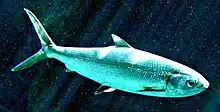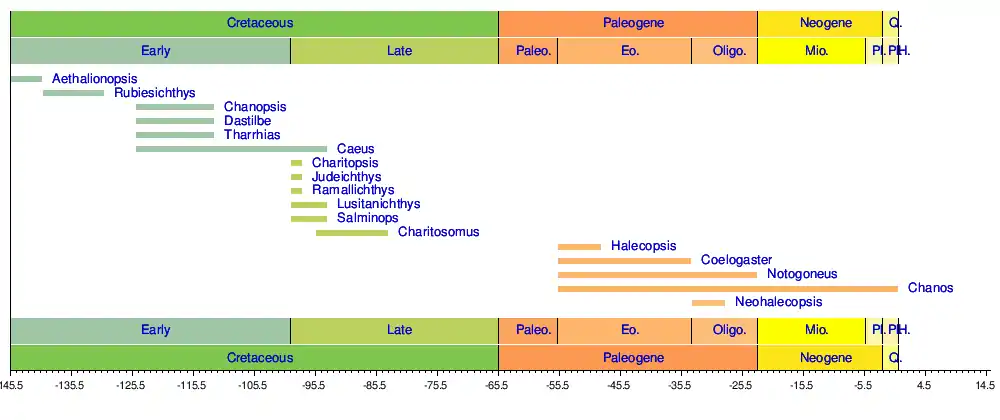Gonorynchiformes
The Gonorynchiformes /ɡɒnəˈrɪŋkɪfɔːrmiːz/ are an order of ray-finned fish that includes the important food source, the milkfish (Chanos chanos, family Chanidae), and a number of lesser-known types, both marine and freshwater.
| Gonorynchiformes Temporal range: Early Cretaceous - Recent | |
|---|---|
 | |
| Milkfish, Chanos chanos | |
| Scientific classification | |
| Domain: | Eukaryota |
| Kingdom: | Animalia |
| Phylum: | Chordata |
| Class: | Actinopterygii |
| Superorder: | Ostariophysi |
| Order: | Gonorynchiformes L. S. Berg, 1940 |
| Type species | |
| Gonorynchus gonorynchus (Linnaeus, 1766) | |
| Families | |
|
Chanidae (milkfish) | |
The alternate spelling "Gonorhynchiformes", with an "h", is frequently seen but not official.
Gonorynchiformes have small mouths and no teeth. They are the sole group in the clade Anotophysi, a subgroup of the superorder Ostariophysi. They are characterized by a primitive Weberian apparatus formed by the first three vertebrae and one or more cephalic ribs within the head. This apparatus is believed to be a hearing organ, and is found in a more advanced and complex form in the related cypriniform fish, such as carp.[1] Also like the cypriniforms, the gonorynchiforms produce a substance from their skin when injured that dissolves into the water and acts an alarm signal to other fish.[2]
Taxonomy
Although many of the families are rather small, there are several fossil genera. This listing of the groups of Gonorynchiformes includes fossil fish with a short description.[1] They are listed in approximate order of how primitive their characteristics are.
| Phylogeny of living Gonorynchiformes[3] | |||||||||||||||||||||||||||||||||||||||
|
- Order †Sorbininardiformes Taverne 1999
- Family †Sorbininardidae Taverne 1999
- Genus †Sorbininardus Taverne 1999
- Family †Sorbininardidae Taverne 1999
- Order Gonorynchiformes Regan 1909[4]
- Suborder Gonorynchoidei - beaked sandfishes
- Family †Apulichthyidae Taverne 1997
- Genus †Apulichthys Taverne 1997
- Family Gonorynchidae Fowler 1941
- †Anormurus de Blainville 1818
- †Chanopsis Casier 1961
- †Charitopsis Gayet 1993 non Trjapitzin 1969
- †Gonorynchidarum otolith
- †Hakeliosomus Gayet 1993
- †Protocatostomus Whitfield 1891
- †Ramallichthys Gayet 1982
- Subfamily †Charitosominae
- †Charitosomus Hosius & Von Der Marck 1885 - Cretaceous
- Subfamily †Judeichthyinae
- †Judeichthys Gayet 1985
- Subfamily Gonorynchinae
- †Notogoneus Cope 1885 - from North America, Europe, Australia; some freshwater; Late Cretaceous to Oligocene
- Gonorynchus Gronow 1763 ex Scopoli 1777
- Family †Apulichthyidae Taverne 1997
- Suborder Chanoidei Berg 1937
- †Aethalinopsis Gaudant 1967 - Early Cretaceous
- Family Chanidae Günther 1868 (milkfishes)
- †Cabindachanos Taverne et al. 2019 - Paleocene[5]
- Subfamily †Rubiesichthyinae Poyata-Ariza 1996
- Genus †Gordichthys Poyata-Ariza 1994- Early Cretaceous Chanid
- Genus †Nanaichthys Amaral & Brito 2012
- Genus †Rubiesichthys Wenz 1984 - Early Cretaceous Chanid
- Subfamily Chaninae
- Genus Chanos Lacépède 1803
- Genus †Dastilbe Jordan 1910 - Early Cretaceous Chanid
- Genus †Francischanos Ribeiro et al. 2022 - Early Cretaceous Chanid[6]
- Genus †Parachanos Arambourg & Schneegans 1935 - Early Cretaceous Chanid
- Genus †Tharrhias Jordan & Branner 1908 - Early Cretaceous Chanid
- Genus †Vango Murray et al. 2023 - Late Cretaceous Chanid[7]
- Suborder Knerioidei
- Family Kneriidae Günther 1868
- Genus †Mahengichthys Davis, Arratia & Kaiser 2013
- Subfamily Kneriinae (Shellears)
- Tribe Cromeriini
- Genus Cromeria Boulenger 1901
- Genus Grasseichthys Géry 1964
- Tribe Kneriini
- Genus Kneria Steindachner 1866
- Genus Parakneria Poll 1965
- Tribe Cromeriini
- Family Phractolaemidae
- Genus Phractolaemus Boulenger 1901 (Hingemouths/snake mudheads)
- Family Kneriidae Günther 1868
- Suborder Gonorynchoidei - beaked sandfishes
Timeline of genera

References
- Nelson, Joseph, S. (2006). Fishes of the World. John Wiley & Sons, Inc. ISBN 0-471-25031-7.
{{cite book}}: CS1 maint: multiple names: authors list (link) - Banister, Keith F. (1998). Paxton, J.R.; Eschmeyer, W.N. (eds.). Encyclopedia of Fishes. San Diego: Academic Press. pp. 96–97. ISBN 0-12-547665-5.
- Thomas J. Near, Alex Dornburga, Matt Friedman (2014): Phylogenetic relationships and timing of diversification in gonorynchiform fishes inferred using nuclear gene DNA sequences (Teleostei: Ostariophysi). Molecular Phylogenetics and Evolution, DOI:10.1016/j.ympev.2014.07.013
- Mikko Haaramo. "Gonorynchiformes". Mikko's Phylogeny Archive. Retrieved 2013-10-26.
- Taverne, Louis; Putter, Thierry DE; Mees, Florias; Smith, Thierry (2019-01-01). "Cabindachanos dartevellei gen. and sp. nov., a new chanid fish (Ostariophysi, Gonorynchiformes) from the marine Paleocene of Cabinda (Central Africa)". Geologica Belgica. doi:10.20341/gb.2018.011. ISSN 1374-8505.
- Ribeiro, Alexandre C.; Bockmann, Flávio A.; Poyato-Ariza, Francisco J. (2022-07-01). "Francischanos, a replacement genus for Dastilbe moraesi Silva-Santos, 1955, from the Quiricó Formation, Lower Cretaceous of the Sanfranciscana basin, Brazil (Ostariophysi: Gonorynchiformes)". Cretaceous Research. 135: 105212. doi:10.1016/j.cretres.2022.105212. ISSN 0195-6671.
- Murray, Alison M.; Brinkman, Donald B.; Friedman, Matt; Krause, David W. (2023-10-17). "A large, freshwater chanid fish (Ostariophysi: Gonorynchiformes) from the Upper Cretaceous of Madagascar". Journal of Vertebrate Paleontology. doi:10.1080/02724634.2023.2255630. ISSN 0272-4634.
- Sepkoski, Jack (2002). "A compendium of fossil marine animal genera". Bulletins of American Paleontology. 364: 560. Archived from the original on 2011-07-23. Retrieved 2011-05-17.